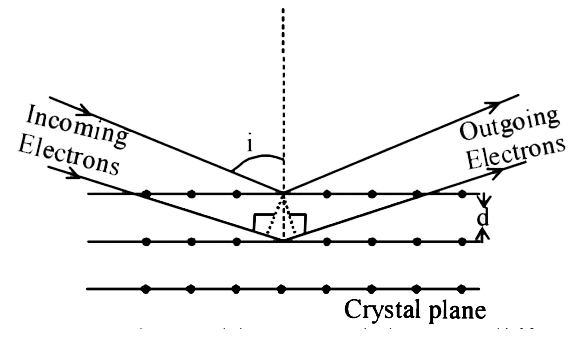COMPETITION FILE (OBJECTIVE TYPE QUESTIONS ( D - Multiple Choice Questions) ) from MODERN PUBLISHERS PHYSICS Chapter 38 DUAL NATURE OF RADIATION AND MATTER for Class 12
| Class 12 | PHYSICS |
| Chapter | DUAL NATURE OF RADIATION AND MATTER |
| MODERN PUBLISHERS PHYSICS | COMPETITION FILE (OBJECTIVE TYPE QUESTIONS ( D - Multiple Choice Questions) ) |
| Medium | English |
| Academic Year | 2023-2024 |
Question 1
A light beam of intensity 3.01×10−3Wm−2 is incident normally on the square -sapped metal surface of side 1 cm and with work function 2 eV . The intensity of light is equal distributed among the three constituents' wavelength , 400 nm, 550 nm and 650 nm. Each photon emits one electron without any loss in the energy.
The energy incident by the light of wavelength 400 nm in one second is View SolutionQuestion 2
A light beam of interest 3.01×10−3Wm−2 is incident normally on the square -sapped metal surface of side 1 cm and with work function 2 eV . The intensity of light is equal distributed among the three constituents' wavelength , 400 nm, 550 nm and 650 nm. Each photon emits one electron without any loss in the energy.
Choose the correct option from the following regarding the photoelectric emission. View SolutionQuestion 3
A light beam of interest 3.01×10−3Wm−2 is incident normally on the square -sapped metal surface of side 1 cm and with work function 2 eV . The intensity of light is equal distributed among the three constituents' wavelength , 400 nm, 550 nm and 650 nm. Each photon emits one electron without any loss in the energy.
The number of electrons emitted per second from the metal surface is View SolutionQuestion 4
Wave property of electrons implies that they will show diffraction effects. Davission and Germer demonstrated this by diffracting electrons from crystals. The law governing the diffraction from a crystal is obtained by requiring that electron waves reflected from the planes of atoms in a crystal interfere constructively (see figure)
_E01_233_Q01.png)
The surface of a metal is illuminated with the light of 400nm. The kinetic energy of the ejected photoelectrons was found to be 1.68eV. The work function of the metal is : (hc=1240eV−nm)View SolutionQuestion 5
Wave property of electron implies that they will show diffraction effected . Davisson and Germer demonstrated this by diffracting electron from crystals . The law governing the diffraction from a crystals is obtained by requiring that electron waves reflected from the planes of atoms in a crystal inter fere constructiely

If a strong diffraction peak is observed when electrons are incident at an angle i from the normal to the crystal planes with distance d between them (see fig) de Brogle wavelength λdB of electrons can be calculated by the relationship (n is an intenger)View Solution
All Exercises from MODERN PUBLISHERS PHYSICS Class 12 PHYSICS DUAL NATURE OF RADIATION AND MATTER
- CHAPTER PRACTICE TEST
- COMPETITION FILE (OBJECTIVE TYPE QUESTIONS ( A - Multiple Choice Questions))
- COMPETITION FILE (OBJECTIVE TYPE QUESTIONS ( B - Multiple Choice Questions) (AIPMT/NEET & Other State Boards for Medical Entrance))
- COMPETITION FILE (OBJECTIVE TYPE QUESTIONS ( B - Multiple Choice Questions) (JEE (Advanced) for IIT Entrance))
- COMPETITION FILE (OBJECTIVE TYPE QUESTIONS ( B - Multiple Choice Questions) (JEE (Main) & Other State Boards for Engineering entrance))
- COMPETITION FILE (OBJECTIVE TYPE QUESTIONS ( C - Multiple Choice Questions) )
- COMPETITION FILE (OBJECTIVE TYPE QUESTIONS ( D - Multiple Choice Questions) )
- COMPETITION FILE (OBJECTIVE TYPE QUESTIONS (ASSERTION REASON TYPE QUESTIONS))
- COMPETITION FILE (OBJECTIVE TYPE QUESTIONS (INTEGER TYPE QUESTIONS))
- COMPETITION FILE (OBJECTIVE TYPE QUESTIONS (MATCHING TYPE QUESTIONS))
- COMPETITION FILE (OBJECTIVE TYPE QUESTIONS (MATRIX MATCH TYPE QUESTIONS))
- Conceptual Questions
- Higher Order Thinking Skills & Advanced Level (QUESTIONS WITH ANSWERS)
- NCERT FILE (NCERT - Additional Exercises)
- NCERT FILE (Textbook Exercises)
- NCERT FILE (NCERT - Exemplar Problems - Objective Questions (Multiple Choice Questions (Type - I)))
- NCERT FILE (NCERT - Exemplar Problems - Objective Questions (Multiple Choice Questions (Type - II)))
- NCERT FILE (NCERT - Exemplar Problems - Subjective Questions (Short Answer Type Questions))
- NCERT FILE (NCERT - Exemplar Problems - Subjective Questions (Very Short Answer Type Questions))
- PRACTICE PROBLEMS - 1
- PRACTICE PROBLEMS - 2
- PRACTICE PROBLEMS - 3
- Revision Exercises (Additional Questions)
- Revision Exercises (Fill in the Blanks)
- Revision Exercises (Long Answer Questions)
- Revision Exercises (Numerical Problems)
- Revision Exercises (Short Answer Questions)
- Revision Exercises (Very Short Answer Questions)
- SOLVED EXAMPLES
- Tough & Tricky PROBLEMS
